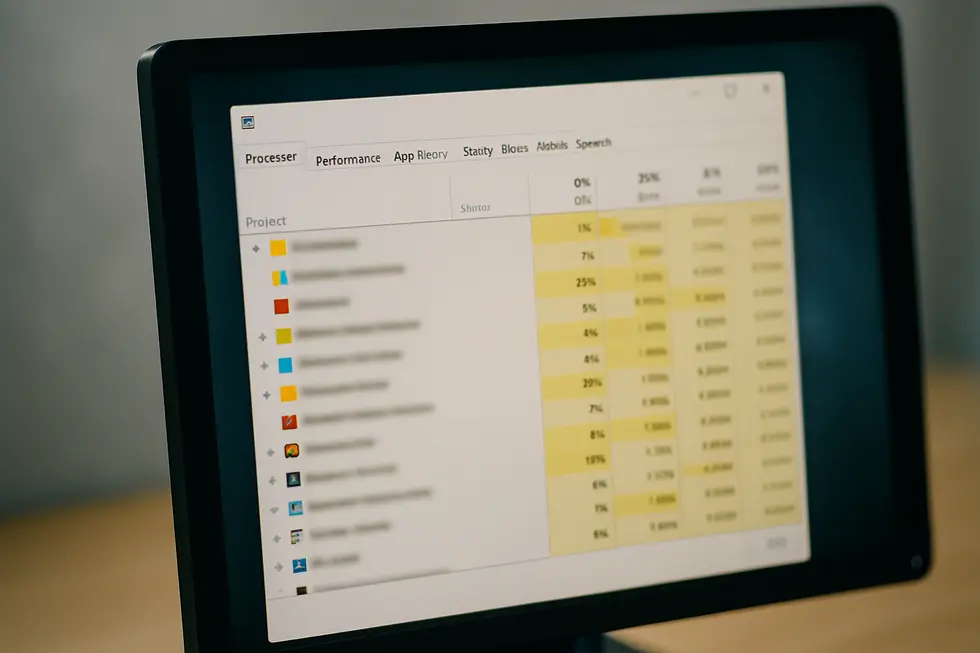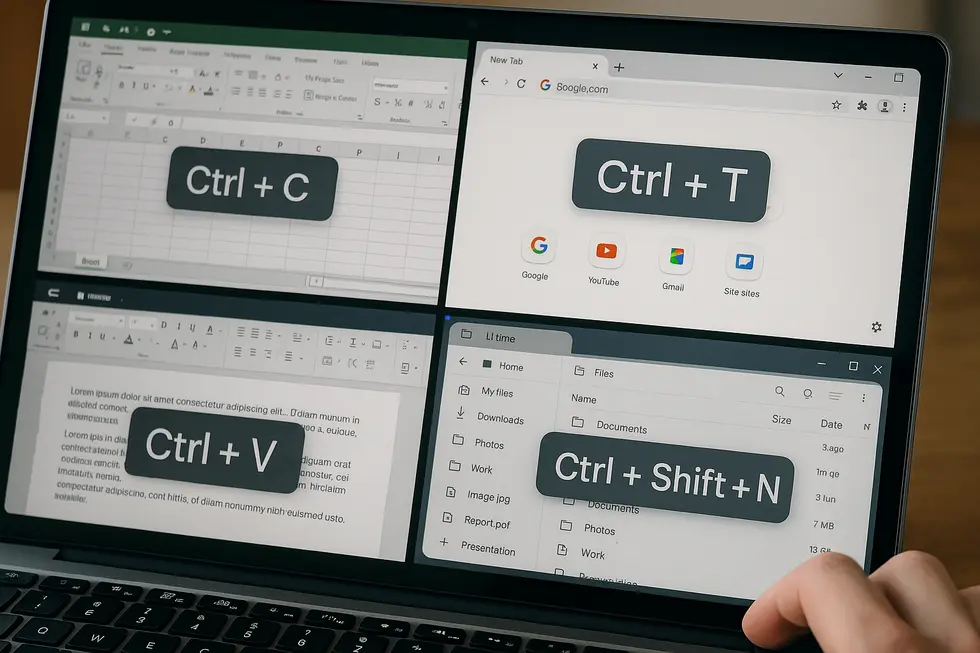Introduction
Dive into the world of keyboard shortcuts designed for true power users, whether you’re a nerd, geek, or tech enthusiast just beginning your journey. This article explores 12 pivotal shortcuts that will revolutionize how you interact with your computer, cutting down your reliance on the mouse and dramatically increasing your productivity. From basic text manipulation to advanced system management and navigation, each chapter unveils how these shortcuts serve as secret weapons in your daily digital arsenal, providing tips, insights, and a light sprinkle of humor along the way.
Tables of Contents
Chapter 1: 12 Keyboard Shortcuts Every Power User Should Know
- Unleashing Workflow Potential: Master the Essential Keyboard Shortcuts for Peak Efficiency
- Transforming Workflows: The Power of 12 Essential Shortcuts for Productivity
- Enriching Performance with Specialized Software Shortcuts
Chapter 2: Core Text Editing Shortcuts: Exploring Ctrl+C, Ctrl+V, and Ctrl+X in 12 Keyboard Shortcuts Every Power User Should Know
- Harnessing the Power of Ctrl+C, Ctrl+V, and Ctrl+X for Seamless Text Editing
- Unlocking Efficiency: Mastering Ctrl+C, Ctrl+V, and Ctrl+X for Seamless Document Management
- Effortless Productivity: Mastering Ctrl+C, Ctrl+V, and Ctrl+X for Seamless Workflow
Chapter 3: Enhancing Navigation Efficiency with 12 Essential Keyboard Shortcuts
- Streamlining Multitasking: The Integral Role of Alt+Tab in Navigation Mastery
- Unlocking Efficiency: Mastering Windows Key Shortcuts for Optimal Navigation
- Mastering Advanced Navigation with Essential Keyboard Shortcuts
Chapter 4: System Management Optimization: Master Shortcuts for Enhancing Efficiency
- Leverage Ctrl+Shift+Esc for Effortless Task Manager Integration
- Streamlining System Management: Mastery of Ctrl+Shift+Esc for Power Users
- Direct Access: Efficiently Launch Windows Task Manager with Ctrl+Shift+Esc
Chapter 5: Diverse Application Contexts of 12 Keyboard Shortcuts Every Power User Should Know: From Excel to Chromebooks
- Excel Mastery: Transforming Productivity through Essential Keyboard Shortcuts
- Streamlining Workflow: Essential Chromebook Shortcuts for Power Users
- Windows Mastery: Unleashing the Power of Essential Shortcuts for Seamless Navigation
Chapter 1: 12 Keyboard Shortcuts Every Power User Should Know

1. Unleashing Workflow Potential: Master the Essential Keyboard Shortcuts for Peak Efficiency
Keyboard shortcuts are an essential component in enhancing workflow efficiency for power users, offering a streamlined alternative to the cumbersome dependency on mouse clicks. Familiar shortcuts like Ctrl+Z and Ctrl+Y, play crucial roles in efficient document editing by enabling quick undo and redo actions. Similarly, Ctrl+C and Ctrl+V facilitate seamless content duplication, optimizing text editing or coding tasks.
The integration of custom shortcuts tailored to specific software environments like Adobe XD or Unity further refines this efficiency, allowing tasks such as asset navigation to be executed swiftly with key combos like Ctrl+T. For specialized processes, automating frequently used phrases or inserting legal symbols through text replacement features can significantly reduce manual effort. As users delve deeper into mastering these shortcuts, unconsciously enhanced productivity becomes a natural byproduct, making complex tasks feel almost effortless.
Investing time in understanding both universal commands and specialized shortcuts provides a robust strategy to eliminate task disruptions and maintain an uninterrupted workflow, maximizing the productivity potential for power users.
2. Transforming Workflows: The Power of 12 Essential Shortcuts for Productivity
Integrating 12 essential keyboard shortcuts into daily routines can dramatically enhance productivity for power users. These shortcuts streamline workflows, minimizing the monotonous tedium of repeated tasks and mouse navigation. In environments like SQL query editors, keys such as F5 to run statements, ALT+BREAK to cancel queries, and universally known shortcuts like CTRL+C for copying make data manipulation faster and more efficient. Creative domains like game development leverage shortcuts like Q, W, E, R in Unity, enabling swift toggling between tools—essential for rapid creativity. Microsoft’s Windows 11 update introduces an innovative AI-powered feature akin to shortcuts, offering contextually relevant actions. These integrations exemplify how mastering these shortcuts doesn’t just save time; it fundamentally shifts users’ focus back to critical tasks, allowing deeper engagement and more meaningful productivity in specialized applications. For more on enhancing workflow efficiency through shortcuts, visit Vagon Blog.
3. Enriching Performance with Specialized Software Shortcuts
Mastering shortcuts in specialized software applications significantly boosts productivity for power users. These shortcuts transcend basic text editing and navigation by enabling advanced operations like inserting hyperlinks or creating new documents with ease. Within specialized software such as data analysis tools, keyboard shortcuts are often combined with macros for streamlined workflows. Universal commands like Ctrl+C (Copy), Ctrl+V (Paste), and Ctrl+Z (Undo) form the foundation, allowing swift and precise controls.
Advanced users leverage software-specific shortcuts extensively, adapting them to cater to unique professional needs. For instance, in Excel, actions such as filling cells down/right go beyond typical editing tasks, enhancing data manipulation efficiency. This primer into 12 critical shortcuts highlights the transformative power of these keys. Understanding and customizing them within specialized environments not only accelerates routine tasks but empowers users to unlock the software’s full potential.
Chapter 2: Core Text Editing Shortcuts: Exploring Ctrl+C, Ctrl+V, and Ctrl+X in 12 Keyboard Shortcuts Every Power User Should Know

1. Harnessing the Power of Ctrl+C, Ctrl+V, and Ctrl+X for Seamless Text Editing
Efficiency in text editing is significantly amplified with the mastery of Ctrl+C, Ctrl+V, and Ctrl+X. These fundamental shortcuts allow power users to swiftly copy, paste, and cut text or objects without derailing their workflow. Ctrl+C is your go-to for copying selected content to the clipboard, serving as the foundation for subsequent edits. Meanwhile, Ctrl+V enables quick insertion of copied items, ensuring seamless content placement across documents. The Ctrl+X shortcut cuts and transfers text, facilitating reorganization without unnecessary retyping. Furthermore, incorporating other shortcuts like Alt+Shift+C and Alt+Shift+V, which manage format copying and pasting, enriches your editing toolkit. Regular use of these shortcuts minimizes menu navigation and mouse dependence, enhancing productivity across various applications. Adopting this streamlined approach to editing not only saves time but also fortifies the user’s control over complex document manipulation tasks.
Learn more about optimizing text editing shortcuts
2. Unlocking Efficiency: Mastering Ctrl+C, Ctrl+V, and Ctrl+X for Seamless Document Management
Ctrl+C (Copy), Ctrl+X (Cut), and Ctrl+V (Paste) compose the quintessential triad of productivity in document management. They efficiently maneuver text and objects within documents, reducing the need for cumbersome mouse actions. By transferring content swiftly and accurately, these shortcuts play a pivotal role in workflow optimization. Ctrl+C duplicates content without moving it, offering a buffer of security during complex editing tasks. Ctrl+X removes and stores content on the clipboard, enabling tidy rearrangements. Ctrl+V then places content precisely where needed, preserving or altering formatting as appropriate. Compatibility with most word processors and platforms makes these shortcuts indispensable, even across specialized software. They significantly diminish error rates compared to manual drag-and-drop methods, streamlining document management. Embracing these shortcuts amplifies efficiency and consistency, proving integral to the ethos of power users everywhere.
3. Effortless Productivity: Mastering Ctrl+C, Ctrl+V, and Ctrl+X for Seamless Workflow
Mastering the core text editing shortcuts—Ctrl+C (Copy), Ctrl+V (Paste), and Ctrl+X (Cut)—is essential for efficient daily computer use, without relying on the mouse. These shortcuts accelerate workflow by quickly duplicating, moving, or removing content. Ctrl+C and Ctrl+X are pivotal for transferring data, while Ctrl+V simplifies placing content where needed. Practicing these over right-click menus significantly speeds up writing, coding, and data entry.
Integration of selection shortcuts, like Shift+arrow keys, enhances precision, while advanced uses, such as Ctrl+Shift+V for ‘paste without formatting,’ ensure clean results. These shortcuts extend beyond text editing, useful in design tools like Adobe InDesign for managing elements seamlessly. Incorporating these into routine tasks minimizes mouse use, reduces strain, and increases productivity, forming a gateway to mastering complex, keyboard-driven workflows across diverse digital environments.
Chapter 3: Enhancing Navigation Efficiency with 12 Essential Keyboard Shortcuts

1. Streamlining Multitasking: The Integral Role of Alt+Tab in Navigation Mastery
The Alt+Tab shortcut is a cornerstone of navigation efficiency for power users operating in Windows environments. By holding down Alt and pressing Tab, users can swiftly toggle between open programs, bypassing the need for mouse input or taskbar navigation. This function facilitates rapid multitasking, an essential capability for enhancing productivity and minimizing workflow interruptions. To elevate command over their digital workspace, users can pair Alt+Tab with other relevant keyboard shortcuts. For instance, Windows+D allows quick access to the desktop, while Windows+L secures privacy by locking the screen instantly. Additionally, the recovery of closed browser tabs using Ctrl+Shift+T, efficient text manipulation with Ctrl+C, V, and X, as well as seamless document management through Ctrl+S and Z, all contribute to a streamlined user experience. Mastery of these shortcuts enables users to operate without interruption, sustaining high productivity levels across diverse tasks. Visit enhanced productivity through keyboard mastery for more insights.
2. Unlocking Efficiency: Mastering Windows Key Shortcuts for Optimal Navigation
Power users can transform their interaction with Windows through strategic use of keyboard shortcuts that drastically reduce dependency on the mouse. The Windows Key plays a central role in this efficiency. By combining it with other keys, users unlock functionalities that enhance navigation and speed. For instance, Windows Key + D swiftly shows or hides the desktop, providing immediate access to desktop icons. The Windows Key + E opens File Explorer, streamlining file management. Windows Key + Tab offers a comprehensive view of all open windows, facilitating effortless task switching, akin to the efficiency of Alt + Tab, which lets users cycle through applications without a mouse. The Windows Key + L ensures security, locking the PC when needed without delay. By mastering these shortcuts alongside general navigation tools like the Tab key and arrow keys, users can achieve a fluid, mouse-free workflow, maximizing productivity.
3. Mastering Advanced Navigation with Essential Keyboard Shortcuts
Advanced Techniques for Speed and Precision outline how Tab and Shift + Tab allow effortless movement through interactive elements on a page, streamlining web navigation. The Enter and Spacebar keys eliminate the need for a mouse click, activating elements swiftly. Arrow keys, crucial in document precision, facilitate navigation within dropdowns. Meanwhile, shortcuts like Windows Key + Tab and Alt + Tab summarize tasks or switch apps instantly, enhancing multitasking. Additionally, Ctrl + Shift + Esc unveils the Task Manager, essential for halting unresponsive programs promptly. Shortcuts such as Home/End and Ctrl + Arrow keys significantly ease text navigation by quickly repositioning the cursor. With these techniques, power users reshape their efficiency landscape, achieving a keyboard-centric command that supports accessibility and boosts daily productivity without relying on mouse dependence.
Chapter 4: System Management Optimization: Master Shortcuts for Enhancing Efficiency

1. Leverage Ctrl+Shift+Esc for Effortless Task Manager Integration
For power users, the Ctrl+Shift+Esc shortcut is indispensable, serving as a swift gateway to the Task Manager. This key combination allows you to promptly address performance issues by opening the Task Manager directly, bypassing more cumbersome alternatives like Ctrl+Alt+Del. This immediacy transforms it into a critical tool, especially in situations where unresponsive applications stall productivity. Integrating this shortcut into your routine enables rapid system evaluations and adjustments, offering a significant boost to efficiency when managing multiple tasks. Mastery of this shortcut, along with alternatives such as Windows Key + R to execute “taskmgr,” greatly complements a power user’s toolkit, enabling seamless transitions between application monitoring and management. By incorporating these strategies, users equip themselves with essential tools for optimal system functionality, ensuring a robust and responsive computing experience.
2. Streamlining System Management: Mastery of Ctrl+Shift+Esc for Power Users
For power users, the ability to immediately access the Windows Task Manager via Ctrl + Shift + Esc is invaluable. This shortcut opens the Task Manager directly, bypassing intermediary steps, providing a quick overview of system performance, including CPU and memory usage. This efficiency reduces the reliance on the mouse and speeds up troubleshooting by facilitating the termination of unresponsive programs instantaneously.
Besides Ctrl + Shift + Esc, other routes to the Task Manager include Ctrl + Alt + Delete and Windows Key + X, both of which reveal the Windows Security screen where Task Manager is an option. Additionally, launching Task Manager through the Windows Key + R dialog followed by typing taskmgr underscores the myriad ways keyboard shortcuts can simplify system management.
These shortcuts, along with others like Ctrl+S for saving and Ctrl+Z for undoing actions, are quintessential tools in optimizing user workflow across a Windows environment. This mastery not only boosts productivity but ensures rapid and streamlined interaction with the system More on Task Manager Shortcuts.
3. Direct Access: Efficiently Launch Windows Task Manager with Ctrl+Shift+Esc
The Ctrl + Shift + Esc shortcut is indispensable for power users, allowing immediate access to the Windows Task Manager. This direct command bypasses cumbersome intermediate steps, offering swift monitoring of system performance, managing active processes, and troubleshooting issues effectively. In scenarios where the system is unresponsive, this shortcut acts as a crucial ’emergency switch’, crucial for navigating advanced system tools. Complementary shortcuts, such as Ctrl + Alt + Del to open the security options menu or Windows Key + X for the Quick Access Menu, expand your options slightly but remain less immediate. For users optimizing workflow through keyboard shortcuts, integrating Ctrl + Shift + Esc into daily use streamlines system management dramatically, enhancing productivity and ensuring the efficient handling of unforeseen lags or freezes.
Chapter 5: Diverse Application Contexts of 12 Keyboard Shortcuts Every Power User Should Know: From Excel to Chromebooks

1. Excel Mastery: Transforming Productivity through Essential Keyboard Shortcuts
For Excel power users, mastering keyboard shortcuts like Ctrl + A for selecting all data speeds up editing processes, while Ctrl + D translates into efficient data replication by filling cells below. Leveraging Alt + L for instant data filtering turns unwieldy datasets into manageable segments, streamlining analysis without touching the mouse. F11 facilitates quick chart creation for vivid data presentations, reducing preparation time. Even simple shortcuts like Ctrl + N open new workbooks, allowing smooth workflow transitions. These commands minimize context switching, promoting a seamless, mouse-free environment. However, OS-level conflicts, particularly on Macs, may require shortcuts to be customized in settings for optimal performance.
2. Streamlining Workflow: Essential Chromebook Shortcuts for Power Users
Chromebooks, with their focus on productivity and efficiency, offer specific keyboard shortcuts to transform user experiences. Among these, Search + Esc for Task Manager access empowers quick problem-solving when apps freeze. The Shift + Alt + M shortcut opens the Files app instantaneously, facilitating seamless file management. For those frequently adjusting device settings, Alt + Shift + S offers a swift transition to system preferences. Multi-user scenarios benefit from Ctrl + Shift + Q (twice) and Ctrl + Alt + . / ,, for fast user switching without lag. Accessibility is prioritized with Ctrl + Alt + Z, activating screen readers without fuss. Not forgetting Linux enthusiasts, Ctrl + Alt + T is indispensable for developers needing terminal access. Finally, classic text editing shortcuts—Ctrl+X, Ctrl+C, Ctrl+V—remain vital across every platform. Mastering this suite of shortcuts on a Chromebook drastically reduces reliance on mouse navigation, elevating efficiency and user satisfaction in diverse settings.
3. Windows Mastery: Unleashing the Power of Essential Shortcuts for Seamless Navigation
Navigating Windows efficiently requires mastering a set of essential keyboard shortcuts that enhance productivity and streamline processing across diverse scenarios. Among these, the Windows key + D and Windows key + M help quickly access and manage the desktop, minimizing open windows in a flash. For those consuming screen space, utilizing the Windows key + Up/Down Arrow provides control by maximizing or minimizing active applications. Alt + Tab remains an indispensable tool for swiftly flipping through tasks without resorting to a mouse.
For multitaskers, the Windows key + Left/Right Arrow enables effortless side-by-side app arrangement, while Windows key + Ctrl + D and Windows key + Ctrl + F4 manage virtual desktops efficiently. Seamless navigation across desktops is further facilitated by Windows key + Ctrl + Left/Right Arrow, creating an unbroken workflow reality.
Moreover, customizable shortcuts through tools like PowerToys can be tailored to specific application needs, enhancing productivity by aligning closely with workflow styles. Mastery of these shortcuts ensures Windows users can navigate and operate their systems with unparalleled fluidity and effectiveness.
Final thoughts
In conclusion, keyboard shortcuts serve as powerful tools for anyone looking to optimize their computer interactions. By mastering the 12 essential shortcuts covered in this guide, you position yourself to perform tasks more efficiently, saving time and enhancing productivity in both general and specialized software contexts. Whether you’re drafting a document, managing open applications, or wrangling Excel spreadsheets, these shortcuts empower you to operate like a true power user.
Elevate your tech skills—start mastering these keyboard shortcuts today for a seamless computing experience!
About us
We specialize in providing insights and tips to enhance your digital proficiency, helping tech enthusiasts from all walks of life optimize their computer interactions for maximum efficiency.
Leave a Reply